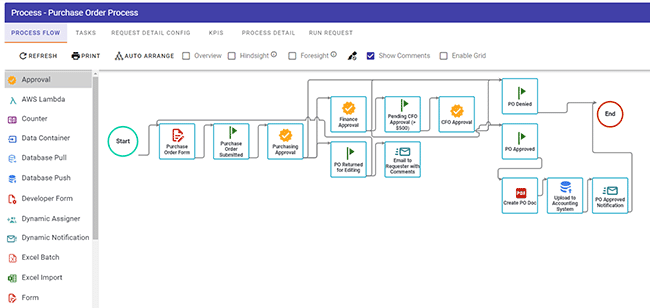Turnaround Time Improvement
Looking for ways to improve turnaround times in your processes? Workflow automation could be the answer.

Turnaround Time Improvement
Looking for ways to improve turnaround times in your processes? Workflow automation could be the answer.
The meaning of "turnaround time" can differ depending on the industry, role, and situation. Let's look at "turnaround time" broadly and dissect various ways you and your business can achieve fast turnaround times for your clients and other work.
What is Turnaround Time?
The general meaning of "turnaround time" is the duration of a process from initiation to completion.
In other words, when you start a process, such as a concrete project deliverable like shipping a product, how long does it take to complete that process? From beginning to end, this duration is "turnaround time." A fast or short turnaround time is far more desirable for most organizations than longer ones.
There may also be multiple measured sub-processes within a process, which we'll discuss below.
Turnaround Time Improvement Examples
Every industry and department has specific processes that are measured for efficiency and effectiveness. In many cases, the time it takes to complete represents real dollars and can present risk. Fast turnaround time means less money spent on the workforce, for instance. If you can achieve short turnaround times without compromising quality, then you should try to do so. Some examples of critical processes that focus on improved turnaround are:
- Healthcare patient turnaround
- New product development
- Consumer loan approvals
- Approval of capital requests
- Laboratory turnaround
In each scenario, the difference between a slow and rapid resolution is significant and can result in poor outcomes and lost opportunities. Not having a quick turnaround time can cost your business real dollars.
 Where is the Problem?
Where is the Problem?
Why does a process yield poor turnaround times? There could be several reasons:
- Workflow is undocumented and not transparent.
- Processes are manual and require a great deal of human intervention.
- Task hand-offs are ill-defined or poorly handled.
- Communication during the process is lacking.
- Systems are disconnected and past their prime.
- Efficiency is never measured or mismeasured, hiding the problems.
A process improvement project can reveal these issues and become the start of an effort to reduce process duration, shorten turnaround times, and improve accuracy, productivity, efficiency, and customer/employee experience.
Learn more about process improvement.
How Can Turnaround Times Be Improved?
When the bottlenecks or mistakes are identified, one of the first places to look is in the manual parts of your workflow. This could mean paper-based forms or documents, emails sent for approval, shared files, spreadsheets used for tracking, etc. These are all signs of manual information handling and decision-making.
Turnaround times can be improved quickly when these manual steps are moved into a workflow automation system. Any step that is predictable or can be directed via business rules is ripe for automation.
Automation is cr itical to reducing turnaround times. Think about the many things that can delay a human worker as part of a project. Other, more urgent tasks may arise. Children may get sick and need to be cared for. Planned vacations may interrupt the schedule. A key employee in a different time zone may have ducked out early for the day, meaning decisions won't be made until the next morning.
itical to reducing turnaround times. Think about the many things that can delay a human worker as part of a project. Other, more urgent tasks may arise. Children may get sick and need to be cared for. Planned vacations may interrupt the schedule. A key employee in a different time zone may have ducked out early for the day, meaning decisions won't be made until the next morning.
Each of these natural events that almost any worker will encounter can build up, compounding upon themselves to increase turnaround time. Because Alan ducked out early, Betty couldn't reach him in time, delaying her getting critical information to Charlotte. Charlotte had blocked out all of Tuesday to work on the project, but because the tasks didn't get to her until Wednesday (when she was in meetings all day), she was late getting information to David… and so on.
Automating workflows and business processes minimizes this risk to achieve a fast turnaround time on all your projects.
Workflow automation provides a variety of tools for improving efficiency and turnaround.
- Alerts and reminders for task owners.
- Escalation options when a task times out.
- KPI dashboards and reporting to measure efficiency and speed.
- Group assignments to ensure tasks and requests are assigned.
- Task delegation.
- Group task reassignment.
All these features, combined with business logic for properly routing tasks and requests, ensure dramatically improved efficiency and speed.
Workflow Automation Overview

Building an automated process can be done via drag-and-drop. A shape represents each task and can be connected to other tasks in the proper sequence (or branch off to another part of the process) to simulate the real-world workflow. The simple act of laying out the entire process immediately makes it transparent to be discussed and critiqued by all stakeholders.
Once stakeholders agree, the correct process can be tested in real-time. Once tests are successful and iterations complete, the process can be rolled out to teams for use in the field.
Instead of paper, phone calls, emails, spreadsheets, and meetings, the system manages the workflow, and tasks are assigned to the right people, as well as alerts, reminders, and escalations when needed. As tasks are completed, the system initiates the next task, and so on, until the process is complete.
How Integrify Reduces Turnaround Bottlenecks
Interested in Automating Your Workflow for Better Efficiency?
We have several resources to help you navigate an automated workflow.
- Workflow Tools and eBooks
- Workflow Ideas Weekly Email Newsletter
- Recorded Demonstration of our Workflow Automation Software
- Request a Live Demonstration



